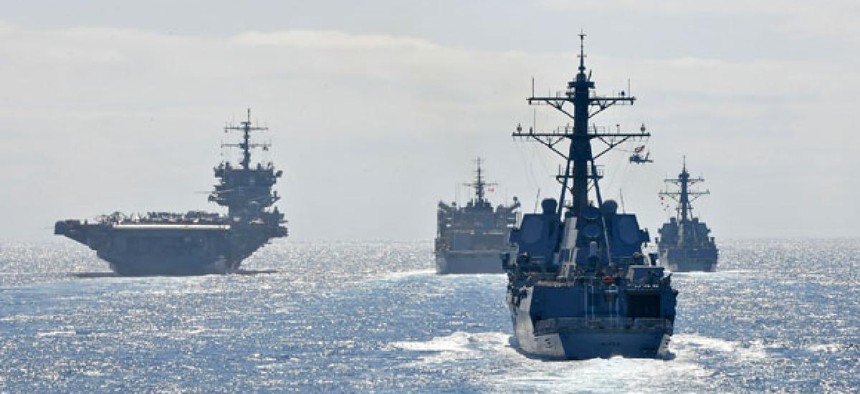Navy’s new network will cost half the previous estimates

United States Navy
Continuous competition after contract award will drive down costs further, official says.
The Navy slashed cost estimates for its Next-Generation Enterprise Network contract to between $4.5 billion and a “maximum value” of $5.398 billion over five years compared to its October 2011 projections of $10 billion, an official told reporters Friday.
The service now expects the network, which will serve 800,000 Navy and Marine personnel, to cost between $900 million and $1.07 billion a year, according to Navy Capt. Shawn Hendricks, Naval Enterprise Networks program manager at the Space and Naval Warfare Systems Command, or SPAWAR.
The lower cost puts NGEN in range with the roughly $1 billion a year the Navy spent on its previous network contracts for the Navy Marine Corps Intranet run by HP Enterprise Services. A $3.4 billion NMCI continuity-of-services contract is set to expire in April 2014. HP and an industry team including Computer Sciences Corp., Cisco Systems Inc. and General Dynamics Information Technology have said they plan to bid on the NGEN contract, which the Navy plans to award in February 2013.
SPAWAR has broken up the NGEN contract into enterprise services -- including myriad software systems -- and transport services, such as base and local area networks and Wi-Fi systems. The command could award separate contracts for each piece, or combine them into a single contract.
Competition won’t end with the award of the NGEN contract, Hendricks said. The network will include 38 types of services, such as enterprise email, and the Navy will have the option to seek competition for those services outside NGEN to get a better deal, he said.
The Defense Information Systems Agency has pitched its ability to host email for all the services, with the Army as its initial customer. Hendricks said he would consider using DISA to provide email for Navy users if it proves a cost-effective approach.
Unlike NMCI, a single network that served the Navy and Marines, NGEN has separate domains for the two services and Brig. Gen. Kevin Nally, the Marine chief information officer, stands adamantly opposed to substituting DISA email for NGEN email.
Defense Systems reported Nally told a DISA conference earlier this month that senior Marine officers said they would “figuratively shoot him in the chest ‘if you make me go to @mail.mil.’ ”
Hendricks portrayed NGEN as a flexible vehicle that can adapt to shifts in technology either through on-contract enhancements, or competition with the use of cloud computing services as a potential future option. This includes using commercial cloud services, if they meet Navy technical requirements.
Asked if the continuous competition on NGEN served as a disincentive to bidders, Hendricks said the contract has built-in incentives that allow the Navy to share cost savings from technical upgrades with NGEN contractors, a setup he viewed as additional profit for the contractor.
SPAWAR spent 18 months developing the NGEN request for proposals released earlier this month, and Hendricks said he personally read 3,500 comments that industry and Navy and Marine users submitted.
While many of those comments were administrative in nature, Hendricks said a vendor suggestion to increase the number of virtual desktops -- thin client computers consisting of a display screen, keyboard and mouse with data stored on a server -- had the potential to save money.
As a result of this suggestion, Hendricks said the Navy increased the number of NGEN virtual desktops on the unclassified network to 119,000 from the 7,500 planned initially and from zero to 15,000 on the classified network.
He emphasized price will drive selection of the NGEN contractor. The Navy is buying standard commercial hardware, software and services and has no intention of paying a premium, he said. The award will be made to the vendor with the “lowest priced, technically acceptable bid,” Hendricks noted.
NEXT STORY: Not-for-profit Hospitals Invest in Health IT



